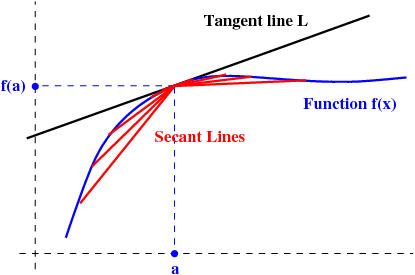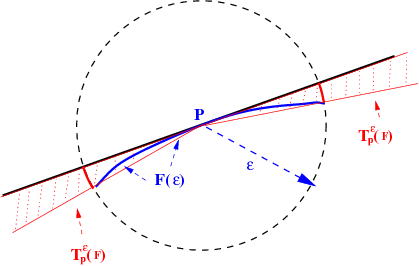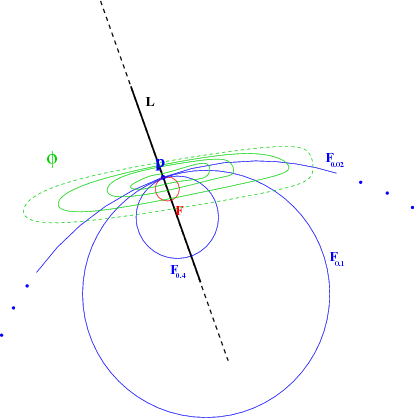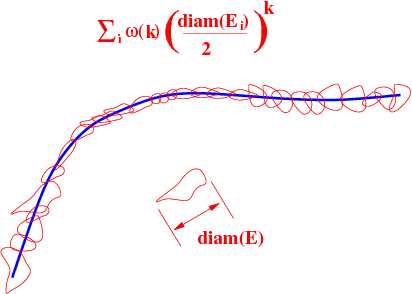While there are a variety of article-length introductions to geometric measure theory, ranging from Federer’s rather dry AMS Colloquium Talks to Fred Almgren’s engaging Questions and Answers to Alberti’s Article for the Encyclopedia of Mathematical Physics, I will take a different approach than has been taken in any of these and introduce geometric measure theory through the vehicle of the derivative.
The Derivative, Geometrically
The derivative that is encountered for the first time in calculus is defined as the limit of a ratio of the “rise” over “run” of the graph of a function. For , this becomes
.
This is visualized as the slope of the secant lines approaching a limit – the slope of the tangent line – as the free ends of those lines approach . This is illustrated in the first figure.
The derivative as , the optimal linear approximation to f at a, is another, very useful way to think about the derivative. Here, we focus on the fact that the tangent line at
approximates the graph of
at
as we zoom in on the graph. More precisely, writing
,
,
where is linear in
,
as
, and the tangent line L is the graph of the function
.
Exercise: use the facts that (1) linear have the form
,
a scalar, and (2)
as
, to rearrange this last equation for
into the original definition of a derivative.
Using the equation above to get
for
,
we are able — after some work (see the exercise below) — to get this nice geometric interpretation:
The figure illustrates the fact that the graph of lies in cones centered on
, whose angular widths go to zero as we restrict ourselves to smaller and smaller
-balls centered on
. Inside the
-ball, the graph stays in the wider cone, while in the smaller,
-ball the graph stays in the narrower cone.
Let’s restate this. Defining
,
to be the ball of radius
centered on
,
,
to be the smallest closed cone, symmetrically centered on
, with vertex at
such that
, and
to be the angular width of
,
we have that
f is differentiable at
Here is a figure illustrating this:
Exercise: provide the missing details taking us from the above inequality bounding the deviation from linearity to the above statement that {f is differentiable at } using the facts that (1) the above inequality defines cones that are almost symmetric about
and (2) the
-ball centered at p is contained in the vertical strip
With this shift to a geometric perspective, we are now in a position to take a step in the direction of geometric measure theory.
Note that in our definition the cones contain all of the graph as they narrow down and we zoom in. But what if all we know is that a larger and larger fraction of the graph is in a narrower and narrower cone as we zoom into p? That is precisely the idea that approximate tangent lines capture. We will introduce two different versions of the concept.
Densities as a path to an approximate tangent line
Tangent Cones
The tangent line discussed above is also the tangent cone. The tangent cone of a set in can have any dimension from 1 to n. For nicely behaved k-dimensional sets, the tangent cone will also be k-dimensional. In the case of the usual derivative of functions from
to
, we are working in the graph space
with 1-dimensional sets. Moving to tangent cones, we can approximate one dimensional sets which are not graphs or, more generally, arbitrary subsets of
.
We now define the tangent cone of at
.
To obtain the tangent cone, begin by translating by
. (This moves
to 0.) Define
. Use a projection center at 0 to project the translated
onto the sphere of radius
centered on 0. Take the closure of the resulting subset of the
-sphere. Finally take the cone over this set. Call this set
. That is,
Now define the tangent cone of F at p to be the intersection of at any sequence of
‘s going to zero;
will do. Thus the tangent cone of
at p,
is given by:
Here is a figure illustrating the key idea:
Note: the tangent cone is centered on the origin, 0, but I will be plotting it as though it were centered on p. Similarly, the tangent lines will sometimes be thought of as linear subspaces (i.e. centered on the origin 0, and other times as the shift of that linear subspace to p.
In the case of a differentiable function , this tangent cone is the usual 1-dimensional tangent line.
Densities
Now we need , the k-dimensional density of F at p.
Define such that it agrees with the volume of the unit ball in
when k is an integer (there is a standard way to do this using
functions). Let
measure k-dimensional volume. Typically this will be k-dimensional Hausdorff measure,
. Whatever intuitive idea you have of k-dimensional measure is good enough for our purposes. (At the end of this post I also define Hausdorff measures more carefully.)
Now, is given by
when this limit exists. When the limit does not exist, we work with the limsup and liminf of the right hand side which are called upper and lower densities of F at p and are denoted by and
respectively.
Approximate Tangent Cones
We now define the approximate tangent cone at p to be the intersection of closed cones whose complements intersected with F have density zero at p:
Originally (in this section), we were aiming at having a definition of approximate tangent line that was invariant to (small) pieces of the set F outside the sequence of cones, provided those pieces got small enough, quick enough. Now we can make that more precise. We want a definition of approximate tangent line that ignores such excursions of F provided these excursions have density zero at p. Rather anti-climatically then, here is the definition we have been waiting for (though you might have already guessed it!)
A 1-dimensional set has an approximate tangent line at
when the approximate tangent cone is equal to a line through p.
When the curve is an embedded differentiable curve, the tangent line and the approximate tangent line are the same.
Remark: in general, when we are dealing with k-dimensional sets in , we will get approximate tangent k-planes.
Exercise: can you create examples of one dimensional sets which have a (density based) approximate tangent line at p but not the usual tangent line at p?
Exercise: prove that a tangent line to a continuous curve is also the (density based) approximate tangent line at p.
Integration as a path to an approximate tangent line
There is different version of approximate tangent k-plane based on integration. (The one dimensional version is of course an approximate tangent line.)
We start with the fact that we can integrate functions defined on over k-dimensional sets using k-dimensional measures
(typically
). We zoom in on the point p, through dilation of the set F:
We will say that the set has an approximate tangent k-plane
at p if the dilation of
, converges weakly to
: i.e. if
for all continuously differentiable, compactly supported .
In the next two figures, we illustrate this for the case of 1-planes – i.e.lines: in the first figure, is the weak limit of the dilations of F, while in the second it is not.
Note: solid green lines are the level sets of while the dashed green line indicates the boundary of the support of
. Note also that the
‘s of 0.4, 0.1, and 0.02 are approximate.
Exercise: can you create an example of a one dimensional curve which has the usual tangent line at p but not an (integration based) approximate tangent line at p?
Closing Note On Hausdorff Measure
We would like a notion of k-dimensional volume or k-dimensional measure. In many cases, the right notion turns out to be k-dimensional Hausdorff measure. We already know what 1,2, and 3-dimensional measure is as long as the objects we are measuring are regular enough, like subsets of lines, rectangles, and cubes. It does not seem too much of a stretch to think that we can extend these measures to things that are somewhat wiggly. That is, we can still easily imagine measuring the length of a subset of a smoothly turning curve, or the area of a piece of a surface that undulates slowly. Hausdorff measure permits us to measure not only such smooth sets (giving the same result as any reasonable extension of the usual Lebesgue measures to the nice cases), but also to measure very wild sets (like fractals).
How to compute the k-dimensional Hausdorff measure of :
- Cover A with a collection of sets
, where
. Here,
is the diameter of
.
- Compute the k-dimensional measure of that cover:
- Define
where the infimum is taken over all covers whose elements with maximal diameter d.
- Finally, we define:
Remark: Suppose that for any , there is a cover
of
, such that
. Then for
,
.
Here is a figure illustrating Hausdorff measures:
Clearly, this can be difficult to compute. It turns out though that in ,
. And by use of mappings, this can take us quite a ways in computing
for integral k and rather general
.
Exercise: Show that if then
and
for
.








You must be logged in to post a comment.